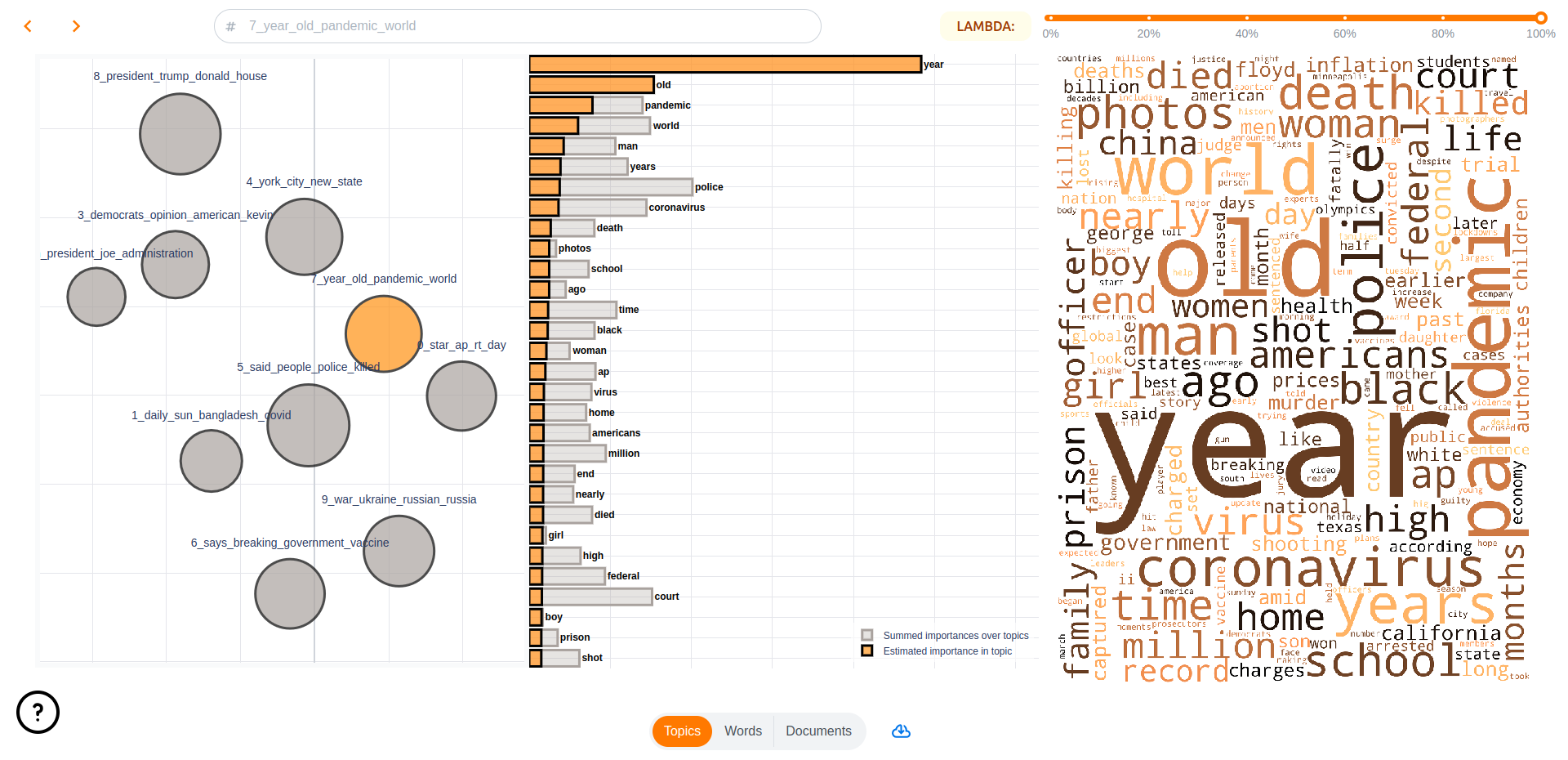Topic modeling is your turf too.
Contextual topic models with representations from transformers.
- Novel transformer-based topic models:
- Semantic Signal Separation - S³ 🧭
- KeyNMF 🔑
- GMM
- Implementations of existing transformer-based topic models
- Clustering Topic Models: BERTopic and Top2Vec
- Autoencoding Topic Models: CombinedTM and ZeroShotTM
- Streamlined scikit-learn compatible API 🛠️
- Easy topic interpretation 🔍
- Dynamic Topic Modeling 📈 (GMM, ClusteringTopicModel and KeyNMF)
- Visualization with topicwizard 🖌️
This package is still work in progress and scientific papers on some of the novel methods are currently undergoing peer-review. If you use this package and you encounter any problem, let us know by opening relevant issues.
KeyNMF can now be used for dynamic topic modeling.
from datetime import datetime
from turftopic import KeyNMF
corpus: list[str] = [...]
timestamps = list[datetime] = [...]
model = KeyNMF(10)
doc_topic_matrix = model.fit_transform_dynamic(corpus, timestamps=timestamps, bins=10)
model.print_topics_over_time()
# This needs Plotly: pip install plotly
model.plot_topics_over_time()Basics (Documentation)
Turftopic can be installed from PyPI.
pip install turftopicIf you intend to use CTMs, make sure to install the package with Pyro as an optional dependency.
pip install turftopic[pyro-ppl]Turftopic's models follow the scikit-learn API conventions, and as such they are quite easy to use if you are familiar with scikit-learn workflows.
Here's an example of how you use KeyNMF, one of our models on the 20Newsgroups dataset from scikit-learn.
from sklearn.datasets import fetch_20newsgroups
newsgroups = fetch_20newsgroups(
subset="all",
remove=("headers", "footers", "quotes"),
)
corpus = newsgroups.dataTurftopic also comes with interpretation tools that make it easy to display and understand your results.
from turftopic import KeyNMF
model = KeyNMF(20).fit(corpus)Turftopic comes with a number of pretty printing utilities for interpreting the models.
To see the highest the most important words for each topic, use the print_topics() method.
model.print_topics()| Topic ID | Top 10 Words |
|---|---|
| 0 | armenians, armenian, armenia, turks, turkish, genocide, azerbaijan, soviet, turkey, azerbaijani |
| 1 | sale, price, shipping, offer, sell, prices, interested, 00, games, selling |
| 2 | christians, christian, bible, christianity, church, god, scripture, faith, jesus, sin |
| 3 | encryption, chip, clipper, nsa, security, secure, privacy, encrypted, crypto, cryptography |
| .... |
# Print highest ranking documents for topic 0
model.print_representative_documents(0, corpus, document_topic_matrix)| Document | Score |
|---|---|
| Poor 'Poly'. I see you're preparing the groundwork for yet another retreat from your... | 0.40 |
| Then you must be living in an alternate universe. Where were they? An Appeal to Mankind During the... | 0.40 |
| It is 'Serdar', 'kocaoglan'. Just love it. Well, it could be your head wasn't screwed on just right... | 0.39 |
model.print_topic_distribution(
"I think guns should definitely banned from all public institutions, such as schools."
)| Topic name | Score |
|---|---|
| 7_gun_guns_firearms_weapons | 0.05 |
| 17_mail_address_email_send | 0.00 |
| 3_encryption_chip_clipper_nsa | 0.00 |
| 19_baseball_pitching_pitcher_hitter | 0.00 |
| 11_graphics_software_program_3d | 0.00 |
Turftopic does not come with built-in visualization utilities, topicwizard, an interactive topic model visualization library, is compatible with all models from Turftopic.
pip install topic-wizardBy far the easiest way to visualize your models for interpretation is to launch the topicwizard web app.
import topicwizard
topicwizard.visualize(corpus, model=model)Alternatively you can use the Figures API in topicwizard for individual HTML figures.
- Kardos, M., Kostkan, J., Vermillet, A., Nielbo, K., Enevoldsen, K., & Rocca, R. (2024, June 13).
$S^3$ - Semantic Signal separation. arXiv.org. https://arxiv.org/abs/2406.09556 - Grootendorst, M. (2022, March 11). BERTopic: Neural topic modeling with a class-based TF-IDF procedure. arXiv.org. https://arxiv.org/abs/2203.05794
- Angelov, D. (2020, August 19). Top2VEC: Distributed representations of topics. arXiv.org. https://arxiv.org/abs/2008.09470
- Bianchi, F., Terragni, S., & Hovy, D. (2020, April 8). Pre-training is a Hot Topic: Contextualized Document Embeddings Improve Topic Coherence. arXiv.org. https://arxiv.org/abs/2004.03974
- Bianchi, F., Terragni, S., Hovy, D., Nozza, D., & Fersini, E. (2021). Cross-lingual Contextualized Topic Models with Zero-shot Learning. In Proceedings of the 16th Conference of the European
- Chapter of the Association for Computational Linguistics: Main Volume (pp. 1676–1683). Association for Computational Linguistics.
